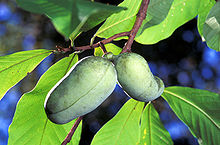Asimina triloba
Asimina triloba, the American papaw, pawpaw, paw paw, or paw-paw, and many other regional names, is a small deciduous tree. It is native to the eastern United States and Canada. The tree grows a large, yellowish-green to brown fruit.[3][4][5] Asimina is the only temperate genus in the tropical and subtropical flowering plant family Annonaceae. Asimina triloba has the most northern range of these.[6] Well-known tropical fruits in family Annonaceae include the custard-apple, cherimoya, sweetsop, ylang-ylang, and soursop.
| Asimina triloba | |
|---|---|

| |
| Asimina triloba in fruit | |
| Scientific classification | |
| Kingdom: | Plantae |
| Clade: | Tracheophytes |
| Clade: | Angiosperms |
| Clade: | Magnoliids |
| Order: | Magnoliales |
| Family: | Annonaceae |
| Genus: | Asimina |
| Species: | A. triloba
|
| Binomial name | |
| Asimina triloba | |

| |
| Natural range of Asimina triloba | |
The pawpaw is a patch-forming (clonal) underbrush tree of hardwood forests. It is found in fertile bottomland and hilly upland habitats.[7] The tree has large, simple leaves. They are more characteristic of plants in tropical rainforests than within the temperate range of this species.[8] Pawpaw fruits are the largest edible fruit indigenous to the United States[9][10]
Pawpaw fruits are sweet. They have a custard-like texture. The flavor of the fruit is similar to banana, mango, and pineapple. They are commonly eaten raw. They are also used to make ice cream and baked desserts. The bark, leaves, and seeds contain the insecticidal neurotoxin annonacin.[11]
References
change- ↑ "Asimina triloba". The IUCN Red List of Threatened Species. 208. IUCN. e.T135958357A135958359. 2018. doi:10.2305/IUCN.UK.2018-2.RLTS.T135958357A135958359.en. S2CID 242070317.
- ↑ "NatureServe Explorer 2.0". explorer.natureserve.org. Retrieved 27 April 2022.
- ↑ Pomper, Kirk W (2019). "Pawpaw: Frequently Asked Questions". Kentucky State University, Cooperative Extension Program. Archived from the original on 30 December 2019. Retrieved 30 December 2019.
- ↑ "Asimina triloba". College of Agriculture and Life Sciences, North Carolina State University. Archived from the original on 2018-04-06. Retrieved 2018-12-19.
- ↑ Layne, DR (1998-02-24). "Pawpaw". NewCrop Factsheet, Purdue University. Archived from the original on 2019-07-11. Retrieved 2018-12-19.
- ↑ Huang, Hongwen; Layne, Desmond; Kubisiak, Thomas (July 2000). "RAPD Inheritance and Diversity in Pawpaw (Asimina triloba)". Journal of the American Society for Horticultural Science. 125 (4): 454–459. doi:10.21273/JASHS.125.4.454.
- ↑ "Native Pawpaw Tree". North Carolina State University. Retrieved 6 October 2022.
- ↑ Pankau, Ryan. "Pawpaw". Illinois Extension Service. University of Illinois Urbana-Champaign. Retrieved 6 October 2022.
- ↑ Pomper, Kirk W.; Layne, Desmond R.; Peterson, R. Neal (1999). "The Pawpaw Regional Variety Trial". hort.purdue.edu. Archived from the original on 2015-04-14. Retrieved 2019-09-26.
- ↑ Matthews, Elizabeth (21 September 2021). "Pawpaw: Small Tree, Big Impact". U.S. National Park Service. Retrieved 16 December 2021.
- ↑ Avalos, J; Rupprecht, J. K.; McLaughlin, J. L.; Rodriguez, E (1993). "Guinea pig maximization test of the bark extract from pawpaw, Asimina triloba (Annonaceae)". Contact Dermatitis. 29 (1): 33–5. doi:10.1111/j.1600-0536.1993.tb04533.x. PMID 8365150. S2CID 41590523.

